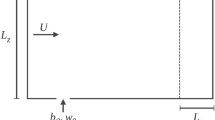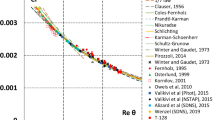Abstract
Large-eddy simulation is used to investigate the Reynolds-number dependence of gas dispersion over a wavy wall, because the Reynolds-number dependence is important for reproducing normal flow and gas dispersion in a wind tunnel. The ratio of amplitude to wavelength of the wavy surface is set to 0.1, and the Reynolds number based on the bulk velocity and the channel height is varied from \(6.67\times 10^{3}\) to \(6.67\times 10^{4}\). Two tracer gases are emitted from point sources located at a single crest and trough of the wavy wall. For the lowest Reynolds number, the flow over the wavy wall separates behind the crest and reattaches to the upslope. A recirculation zone is observed near the trough, and the gas emitted from the trough is transported upwind by the recirculating reverse flow. Some gas is discharged from the valley by intermittent velocity bursts that originate in the recirculation zone. As the Reynolds number is increased, the recirculation zone shrinks and the flow increasingly follows the wavy wall. The gas generally disperses in the forward direction and is discharged by the advective flow. As for the gas emitted from the crest, this disperses with the separating flow, while some gas is trapped within the recirculation zone at the lower Reynolds number. As the Reynolds number is increased, the gas advection increasingly follows the wavy wall and the height of the peak concentration approaches the wavy wall. In addition, the accumulated concentration within the valley in both sources depends strongly on the Reynolds number.













Similar content being viewed by others
References
Antonopoulos-Domis M (1981) Large eddy simulation of a passive scalar in isotropic turbulence. J Fluid Mech 104:55–79
Ayotte KW, Hughes DE (2004) Observations of boundary-layer wind-tunnel flow over isolated ridges of varying steepness and roughness. Boundary-Layer Meteorol 112:525–556
Cai X-M, Barlow JF, Belcher SE (2008) Dispersion and transfer of passive scalars in and above street canyons—Large-eddy simulations. Atmos Environ 42:5885–5895
Calhoun RJ, Street RL, Koseff JR (2001) Turbulent flow over a wavy surface: stratified case. J Geophys Res 106:9295–9310
Castro IP, Robins AG (1977) The flow around a surface-mounted cube in uniform and turbulent streams. J Fluid Mech 79:307–335
Chang K, Hughes TJR, Calo VM (2012) Isogeometric variational multiscale large-eddy simulation for fully-developed turbulent flow over a wavy wall. Comput Fluids 68:94–104
Cheng WC, Liu C-H (2011) Large-eddy simulation of flow and pollutant transports in and above two-dimensional idealized street canyon. Boundary-Layer Meteorol 139:411–437
Cherukat P, Na Y, Hanratty TJ, McLaughlin JB (1998) Direct numerical simulation of a fully developed turbulent flow over a wavy wall. Theor Comput Fluid Dyn 11:109–134
Choi HS, Suzuki K (2005) Large eddy simulation of turbulent flow and heat transfer in a channel with one wavy wall. Int J Heat Fluid Flow 26:681–694
De Angelis V, Lombardi P, Banerjee S (1997) Direct numerical simulation of turbulent flow over a wavy wall. Phys Fluids 9:2429–2442
Errico O, Stalio E (2014) Direct numerical simulation of turbulent forced convection in a wavy channel at low and order one Prandtl number. Int J Therm Sci 86:374–386
Günther A, Rudolf von Rohr PH (2002) Structure of the temperature field in a flow over heated waves. Exp Fluids 33:920–930
Henn D, Sykes RI (1999) Large-eddy simulation of flow over wavy surfaces. J Fluid Mech 383:75–112
Hudson JD (1993) The effect of a wavy boundary on a turbulent flow. PhD Thesis, University of Illinois, Urbana
Hudson JD, Dykhno L, Hanratty TJ (1996) Turbulence production in flow over a wavy wall. Exp Fluids 20:257–265
Ishihara T, Hibi K, Oikawa S (1999) A wind tunnel study of turbulent flow over a three-dimensional steep hill. J Wind Eng Ind Aerodyn 83:95–107
Issa R (1986) Solution of implicitly discretized fluid flow equations by operator splitting. J Comput Phys 62:40–65
Kuzan JD, Hanratty TJ, Adrian RJ (1989) Turbulent flows with incipient separation over solid waves. Exp Fluids 7:88–98
Lilly DK (1992) A proposed modification of the Germano subgrid-scale closure method. Phys Fluid A4:633–635
Liu C-H, Barth MC (2002) Large-eddy simulation of flow and scalar transport in a modeled street canyon. J Appl Meteorol 41:660–673
Liu C-H, Barth MC, Leung DYC (2004) Large-eddy simulation of flow and pollutant transport in street canyons of different building-height-to-street-width ratios. J Appl Meteorol 43:1410–1424
Liu C-H, Leung DYC, Barth MC (2005) On the prediction of air and pollutant exchange rates in street canyons of different aspect ratios using large-eddy simulation. Atmos Environ 39:1567–1574
MaaßC, Schumann U (1996) Direct numerical simulation of separated turbulent flow over a wavy boundary. In: Hirchel EH (ed) Flow simulation with high-performance computers. Notes on numerical fluid mechanics, vol 48, pp 227–241
Michioka T, Sato A (2012) Effect of incoming turbulent structure on pollutant removal from two-dimensional street canyon. Boundary-Layer Meteorol 145:469–484
Michioka T, Sato A, Kanzaki T, Sada K (2007) Wind tunnel experiment for predicting a visible plume region from a wet cooling tower. J Wind Eng Ind Aerodyn 95:741–754
Michioka T, Sato A, Takimoto H, Kanda M (2011) Large-eddy simulation for the mechanism of pollutant removal from a two-dimensional street canyon. Boundary-Layer Meteorol 138:195–213
Michioka T, Takimoto H, Sato A (2014) Large-eddy simulation of pollutant removal from a three-dimensional street canyon. Boundary-Layer Meteorol 150:259–275
Michioka T, Takimoto H, Ono H, Sato A (2016) Effect of fetch on a mechanism for pollutant removal from a two-dimensional street canyon. Boundary-Layer Meteorol 160:185–199
Ohya Y (2001) Wind-tunnel study of atmospheric stable boundary layers over a rough surface. Boundary-Layer Meteorol 98:57–82
OpenFOAM (2012) OpenFOAM: the open source CFD toolbox. http://www.openfoam.com/
Rossi R (2010) A numerical study of algebraic flux models for heat and mass transport simulation in complex flows. Int J Heat Mass Transf 53:4511–4524
Rossi R, Iaccarino G (2009) Numerical simulation of scalar mixing from a point source over wavy wall. Center for Turbulence Research, Annual Research Briefs, pp 453–464
Snyder WH, Castro IP (2002) The critical Reynolds number for rough-wall boundary layers. J Wind Eng Ind Aerodyn 90:41–54
Teunissen HW, Shokr ME, Bowen AJ, Wood CJ, Green DWR (1987) The Askervein hill project: wind-tunnel simulations at three length scales. Boundary-Layer Meteorol 40:1–29
Tseng YH, Ferziger JH (2004) Large-eddy simulation of turbulent wavy boundary flow—illustration of vortex dynamics. J Turbul 5:N34
Uehara K, Wakamatsu S, Ooka R (2003) Studies on critical Reynolds number indices for wind-tunnel experiments on flow within urban areas. Boundary-Layer Meteorol 107:353–370
Wagner C (2007) Transport phenomena in complex turbulent flows: numerical and experimental methods. Diss. ETH No. 17405, ETH Zurich
Wagner C, Kuhn S, Rudolf von Rohr P (2007) Scalar transport from a point source in flows over wavy walls. Exp Fluids 43:261–271
Wagner C, Kenjeres S, Rudolf von Rohr P (2010) Dynamic large eddy simulations of momentum and wall heat transfer in forced convection over wavy surfaces. J Turbul 12:N7
Yoon HS, El-Samni OA, Huynh AT, Chun HH, Kim HJ, Pham AH, Park IR (2009) Effect of wave amplitude on turbulent flow in a wavy channel by direct numerical simulation. Ocean Eng 36:697–707
Zilker DP, Hanratty TJ (1979) Influence of the amplitude of a solid wavy wall on a turbulent flow. Part 2. Separated flows. J Fluid Mech 90:257–271
Zilker DP, Cook GW, Hanratty TJ (1977) Influence of the amplitude of a solid wavy wall on a turbulent flow. Part 1. Non-separated flows. J Fluid Mech 82:29–51
Acknowledgements
This research was supported by the Japan Society for the Promotion of Science (JSPS), KAKENHI (15K06343).
Author information
Authors and Affiliations
Corresponding author
Rights and permissions
About this article
Cite this article
Michioka, T., Takimoto, H., Ono, H. et al. Reynolds-Number Dependence of Gas Dispersion Over a Wavy Wall. Boundary-Layer Meteorol 164, 401–418 (2017). https://doi.org/10.1007/s10546-017-0261-2
Received:
Accepted:
Published:
Issue Date:
DOI: https://doi.org/10.1007/s10546-017-0261-2




